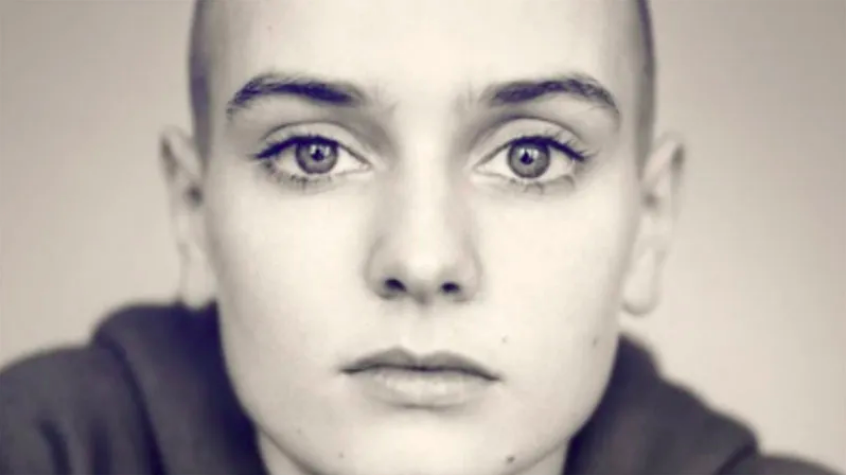There is one thing about having been a “delinquent” teen, or a “freak” as we called ourselves, in the chaos of the early 90s that really makes it seem like we were part of something special—a kind of revolution. At the very least, this time was a powerful shift in youth culture. The most amazing part of that time for me was being accompanied through my tumultuous youth by some powerful, strange, and beautiful musicians. For that I always felt very lucky. I know each era has its musical heroes, but something was really special about ’90s music, I think. And as I’ve written about before, music has been an immensely important part of my life and my healing.
The ‘90s were chock-full of brave women artists especially. But, Sinéad O’Connor, or Shuhada’ Sadaqat (the name she adopted after converting to Islam in 2018), may have been the most bold, the most unique of all the musicians of that time. She was a woman from Dublin who took on the Pope on night time television, for goodness’ sake.
 When I first heard songs like Nothing Compares 2 U on the radio I was transfixed, like so many of us were, by her voice and the power of it. But when she ripped the picture of the Pope in protest of sexual abuse within the church, the rage of young girls all over the world who were experiencing patriarchal oppression was right there—right there represented on the TV. It was earth shattering as a young girl to see that kind of bravery. While my friends and I thought refusing to shave our legs and listening to Riot Grrrl bands were the best protests we could muster, she was doing something quite unimaginably, irrevocably radical.
When I first heard songs like Nothing Compares 2 U on the radio I was transfixed, like so many of us were, by her voice and the power of it. But when she ripped the picture of the Pope in protest of sexual abuse within the church, the rage of young girls all over the world who were experiencing patriarchal oppression was right there—right there represented on the TV. It was earth shattering as a young girl to see that kind of bravery. While my friends and I thought refusing to shave our legs and listening to Riot Grrrl bands were the best protests we could muster, she was doing something quite unimaginably, irrevocably radical.
As I entered into my young adulthood, my life quickly turned into that of a survivor of psychiatric abuse. I became an angry woman diagnosed “crazy” in my early 20s. Just like me, in the early 2000s she was diagnosed with bipolar (which she later stated was a misdiagnosis and did not identify with). I still think Sinéad is unmatched in bravery as far as public protest music and performance in our time. But not many know how she took on stigma and psychiatry, too.
When I became an activist in mental health, I encountered the video plea she released in 2017 from a hotel in New Jersey, and the thought immediately crossed my mind of how often psychiatry is used to silence a person who has strong radical views. It certainly wouldn’t be the first time that an angry woman was destroyed for her feelings, thoughts, and views through stigma, isolation, and chemical restraint. It’s really a tale as old as psychiatry itself. This quote from a review of the movie The Mad Woman’s Ball on CNN is worth including, we all know this story: “It’s a tale as old as time: A woman won’t conform to societal norms, traditional notions of femininity or what’s expected of her, and is dismissed as diseased. She’s considered hysterical. And, as such, she is locked up, burned at the stake, hidden away or placed under the supposedly steadier control of men.”
And, of course, this type of targeting is not just reserved for women. Certainly people of color, Indigenous people, queer, and trans people all experience this.
It was when I found her video online that I started to see what had happened to this bold, immensely creative protest singer of my youth. A new light was brought to Sinéad’s life in my mind, to her music, and I had a new understanding of her suffering and mine. I felt a kinship and a solidarity with her, as many people who have struggled with isolation, suicidality, and stigma must have had.
I sometimes think about how we feel artist’s private lives are ours to judge, invade, and endlessly pontificate upon, just because they’ve offered us artwork that feels vulnerable and raw. But, I am writing this in the spirit of Sinéad’s protests of injustice. Not only did she remind me in my teens to be brave and create art that challenges the injustices of the world, she reminded me as a grown woman not to be silent about the abuses happening to people labeled mentally ill. Throughout the years, she was vocal about Israel/Palestine, abortion, sexual abuse and the church, even the corruption of the Grammys, and, in this video, she was vocal about the neglect and hardship she and so many others experience when struggling with trauma, stigma, and suicidal thoughts.
She was one of millions, she repeated in the video, one of millions.
And she was right. Just like she was right about sexual abuse in the church. She was vocal in a way I don’t know any other musicians have been about the impact of diagnosis, stigma, and psychiatry on her life, how she was dismissed and abandoned at that time by the public and her family.
This video brought me to her music again. And when she passed, I blasted her music all day. She was such a powerful creative force. In 2017, after this video came out, the media framed her emotionality as “Sinéad raises concern for her mental health.” I saw it as yet another courageous and powerful protest, a bit like ripping the Pope’s picture, but this time showing the pain and neglect that people labeled mentally ill suffer with. Many seemed to view this plea as hysterical, dramatic, something to deride or mock. But I listened carefully. It is not just a cry for help; it is a condemnation of how we treat people in mental distress.
There is probably no better tribute on the web right now to Sinéad than Amanda Palmer’s, which you can read here. And I want to add to it by remembering her experience as it is reflected in this video. That she was, in so many ways persecuted by stigma and psychiatry. “Death by a thousand paper cuts.” Palmer says. Like so many of us loud, angry women trapped in a broken system of mental health, I certainly can relate some days.
In the video, she pleads for just some compassion, and asks why we treat each other this way. She gives voice to all people labeled mentally ill who are ignored, and in her cries for justice and compassion for herself, she shows how much she felt in solidarity with others. Even crying out for a woman a few hotel rooms down who had been abandoned, too.
I listened again to the video, a day after the announcement of her death, which came shortly after her son died by suicide in 2022. It reminds me of my peers in the withdrawal community, desperately trying to get the help they need but finding so much stigma, isolation, and loneliness, not just from the medical community, but from family and friends, too.
So, in her tragic passing, I choose to honor her by raising up these words she said, by hearing and believing them. In this interview with Dr. Phil, after her raw and profoundly powerful plea to her family to take care of her after a hysterectomy which she was given no hormone replacements for, when he asked if she considered herself mentally ill.
“No,” she said confidently, “No, not unless you consider complex post-traumatic stress a mental illness.”
I often remind people of this. How the label of mental illnesses, like depression and bipolar, too, are sometimes used to mask the effects of abuse and trauma, which Sinéad had been open about having had plenty of in her life. Diagnosis like these are also so often used to dismiss someone’s feelings, as Sinéad refers to as well.
American author and queer activist Glennon Doyle raised up an important point to remember when talking about survivors of abuse and trauma, or even political targeting, who have been labeled mentally ill. She wrote on Twitter, “why is everyone saying sinead “battled her own demons?” she was one of very few brave enough to battle real demons: child predators, those who protected them in God’s name, homophobia, greed that kills….. she battled demons, yes- but they were us, not her.” Sinéad’s struggles were very real, and not to be dismissed by labeling her mentally ill – putting the fault in her body, her biology, instead of our society and the injustices she fought.
There are plenty of instances you can find of Sinéad referring to herself as mentally ill, but she has also said that she was misdiagnosed with bipolar in an article on the Irish Mirror. She spoke about the effects of prescription psychiatric drugs on her life, and on her hormonal health: “They are extremely debilitating drugs. Tiring to the extreme. Ironically, extremely depressing. They can cause suicidal or self-harm type thinking. They can mess up your menstrual cycle very badly and cause you to be incapacitated for a week before.”
I choose to honor her by helping others understand how common suicidal feelings are, not just in the context of trauma or drug side effects, but for everyone, especially among trauma survivors (including veterans). And to remind you how being able to talk about suicidal feelings without stigma or the threat of diagnosis, or incarceration in mental hospitals, can help people stay alive and heal. There are resources that aim to remove the stigma, like Alternatives to Suicide; you can find more information here.
I choose to remind you, too, that sometimes the best thing we can do for the people we love is to allow them to speak about their feelings without pathologizing or labeling them as manifestations of illness. To honor their suffering. To listen.
Sinéad was a warrior and in many ways paid the ultimate price for her bravery. Whether it was being vilified by the public or the media for a radical protest, or by being stigmatized and dismissed as an angry woman labeled mentally ill—her songs show her brave, vulnerable openness, and her willingness to tell the truth for others. Like she says in the 2017 video, “I hope this is somehow helpful to others,” and that’s what brave artists do, they reveal inner truths, no matter how ugly, political truths, injustices, and pain we usually turn away from, and they make beautiful songs of them.
In the sprit of MIA’s Song of the Week feature, I’ve made a playlist of all the songs that I feel reveal, in her beautiful musical compositions and lyrics, the human experience of mental distress, trauma, love, loss, and healing. How art and music is a place where healing happens for all of us when warriors like her sing from the heart of it. We are blessed to have had her work, and her presence in our time.
I don’t know if there is a special place artists go to find peace when they pass away, after honoring that bargain we make to create the kind of work she did, but I do hope she is there—peaceful, with her son in that healing room.
****
Just hit play below. Each song in this playlist will follow the last. The songs include: Three Babies, Drink Before the War, Thank You for Hearing Me, In This Heart, Just like U Said It Would B, The Healing Room, and Feel So Different.















Thank you for writing this. What a beautiful brave soul Sinead proved herself to be. I shared hospital hallways with her on a number of occasions. Her passing has sent a ripple through all the beautiful souls she encountered there, across the island or Ireland and indeed across the entire world. We in Ireland have bid farewell to a modern day Goddess. I’ve no doubt her work will continue from the spirit realm. Rest easy a while Sinead. And thank you. We see you. We hear you. We feel you.
Report comment
Karin, thanks so much for your beautiful, power essay on Sinead O’Connor! I am deeply moved. I did not know her at all before. As I am reading about her and her life, I am fascinated!
Report comment
She had big strong emotions. Society has no room for those. Her plea from the cheap hotel room in New Jersey heart breaking, every one should watch.
Report comment
Great artists make people look at themselves which is something a lot of people would rather not do.
Report comment
Sinéad O’Connor was a woman ahead of her time. I remember her ripping up the picture of the pope, but I never knew she did that to protest the sexual abuse by priests in the Catholic Church. She was so right to do that and she paid a heavy price. I also never knew until now about the abuse and trauma in her background as well as her awful time in a Magdalene Laundry. She was a pioneer and a brave soul. Thank you, Karin, for this lovely tribute to her memory and her arresting music.
Report comment
I remember hearing Sinead O’Connor’s music for the first time. Anyone who had ever been Mad could hear the Madness in her voice. Before then, I had observed Madness only in spaces of oppression: homes, cages, special education classes. There are many people who have Ms. O’Connor to thank for bringing Madness into their experience of mainstream life. To me, she’s a hero.
Report comment
Nice one,
In the spirit of her reversion (not conversion) to Islam, it is said in the hadiths that the Prophet Muhammad (saw) said the greatest form of Jihad is to speak a word of truth to an oppressive ruler.
I find it fascinating that psychiatric diagnoses deny the person the fundamental human right to practice their religion (to be a Muslim one must be of sound mind) but that Islam does not recognise the fraud and slanderous labels of psychiatry. How many of the prophets were labelled ‘mad’? See Dr Moncrieffs journal article “Psychiatric Diagnosis as Political Device”, the Satanic Verses of this cult disguised as ‘medicine’.
15:6
وَقَالُواْ يَـٰٓأَيُّهَا ٱلَّذِي نُزِّلَ عَلَيۡهِ ٱلذِّكۡرُ إِنَّكَ لَمَجۡنُونٞ
“They say: “O thou to whom the Message is being revealed! truly thou art mad (or possessed)!”
inna lilahi wa inna illahi rajioon Sister.
Interesting also that women ‘activists’ in Iran are being ‘diagnosed’ with “anti family personality disorder” as a means to arbitrarily incarcerate and silence their voices over the wearing of hijab? Mind you, unlike Australia, they are not using force to ‘treat’ these activists for these fabricated illnesses. The use of ECT on young women in my State had to be legally sanctioned before doctors would start the ‘forced/coerced treatments’ on 14 year olds.
Report comment
Profound. Thank you Mad in America. This essay sent shivers down my Spine.
Report comment
BBC News – Antidepressants: I wasn’t told about the side-effects
https://www.bbc.co.uk/news/uk-scotland-66430817
“…Dylan, from Glasgow, was treated with the antidepressant Fluoxetine from the age of 16.
But when he turned 18, his medication was changed to Sertraline.
Within two months of his prescription change he had taken his own life….”
Sinéad O’Connor
“…They are extremely debilitating drugs. Tiring to the extreme. Ironically, extremely depressing. They can cause suicidal or self-harm type thinking. They can mess up your menstrual cycle very badly and cause you to be incapacitated for a week before…”
Report comment
Thank you so much for all these responses.
Report comment